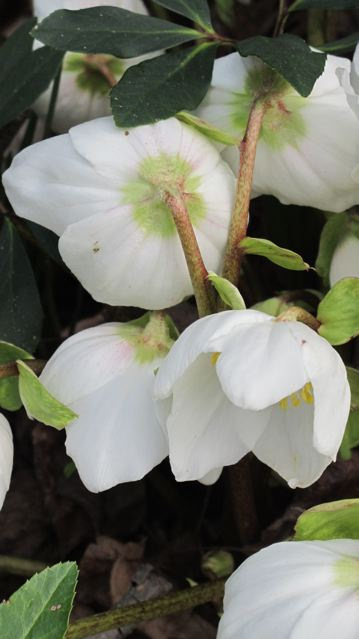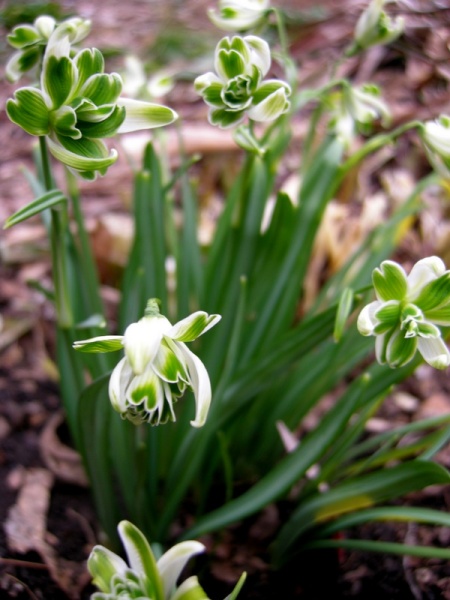 ‘Wendy’s Gold’ is an elegant beauty. It has taken me eight years to capture on film the graceful look and beautiful stature of this snowdrop.
‘Wendy’s Gold’ is an elegant beauty. It has taken me eight years to capture on film the graceful look and beautiful stature of this snowdrop.
In my last post The 2019 Snowdrop Season Part One, I showed some of my snowdrop photos that really communicate the essence of that particular selection. To read it, click here. I explained that there is nothing I like better than roaming around our garden photographing my collection and focusing on the differences that make each snowdrop so special. The cold weather we have been experiencing is prolonging the snowdrop season, and many have yet to bloom. Here are some more of my other recent captures:
Nursery News: Carolyn’s Shade Gardens is a retail nursery located in Bryn Mawr, PA, specializing in showy, colorful, and unusual plants for shade. The only plants that we ship are snowdrops and miniature hostas. For catalogues and announcements of events, please send your full name, location, and cell number (for back up use only) to carolyn@carolynsshadegardens.com. Click here to get to the home page of our website for catalogues and information about our nursery and to subscribe to our blog.
 ‘Wendy’s Gold’ in a group. It is a good multiplier for me in a sloped location in my rock garden that gets deciduous shade. I am currently trying it in two other locations. There is a lot of variability in the growth rate of different snowdrops in different cultural conditions, and I am constantly experimenting.
‘Wendy’s Gold’ in a group. It is a good multiplier for me in a sloped location in my rock garden that gets deciduous shade. I am currently trying it in two other locations. There is a lot of variability in the growth rate of different snowdrops in different cultural conditions, and I am constantly experimenting.
.
 Galanthus reginae-olgae, sometimes called Queen Olga’s snowdrop as it was named after Queen Olga of Greece, blooms around October 15 in my garden. During this unusual 2018-2019 season, the flowers lasted forever—this photo was taken December 3. It received a coveted Award of Garden Merit from the Royal Horticultural Society (“RHS AGM”), one of only 28 snowdrops to do so.
Galanthus reginae-olgae, sometimes called Queen Olga’s snowdrop as it was named after Queen Olga of Greece, blooms around October 15 in my garden. During this unusual 2018-2019 season, the flowers lasted forever—this photo was taken December 3. It received a coveted Award of Garden Merit from the Royal Horticultural Society (“RHS AGM”), one of only 28 snowdrops to do so.
.
 ‘Three Ships’ never disappoints and always sails in around Christmas. However, it is very slow to multiply. RHS AGM
‘Three Ships’ never disappoints and always sails in around Christmas. However, it is very slow to multiply. RHS AGM
.
 On the other hand, ‘Faringdon Double’ blooms between Christmas and New Years and is a vigorous multiplier. It took five years of attempts to portray all it charms in this photo.
On the other hand, ‘Faringdon Double’ blooms between Christmas and New Years and is a vigorous multiplier. It took five years of attempts to portray all it charms in this photo.
.
 ‘John Gray’ is an early snowdrop with very large flowers. It was selected by avid gardener John Gray of Suffolk, England, and rescued from his garden, along with the famous ‘Mighty Atom’, and named by renowned horticulturist Bertram Anderson after Gray died in 1951. RHS AGM
‘John Gray’ is an early snowdrop with very large flowers. It was selected by avid gardener John Gray of Suffolk, England, and rescued from his garden, along with the famous ‘Mighty Atom’, and named by renowned horticulturist Bertram Anderson after Gray died in 1951. RHS AGM
.
 ‘Merlin’, along with the other iconic snowdrops ‘Magnet’, ‘Galatea’, and ‘Robin Hood’, were all selected by James Allen, called by the book The Galanthophiles “one of the greatest of all galanthophiles.” I have found its particular combination of large bright white outer segments with bright green inner segments edged in white to be particularly difficult to show on film. After nine years of trying, I am happy with this photo. Although other snowdrops have come along with solid green inners, I do not think ‘Merlin’ has met it’s match. RHS AGM
‘Merlin’, along with the other iconic snowdrops ‘Magnet’, ‘Galatea’, and ‘Robin Hood’, were all selected by James Allen, called by the book The Galanthophiles “one of the greatest of all galanthophiles.” I have found its particular combination of large bright white outer segments with bright green inner segments edged in white to be particularly difficult to show on film. After nine years of trying, I am happy with this photo. Although other snowdrops have come along with solid green inners, I do not think ‘Merlin’ has met it’s match. RHS AGM
.
 ‘Starling’ is a much more recent introduction selected by my friend the internationally famous snowdrop expert Alan Street at Avon Bulbs in England. Its name means little star. In my garden it is very vigorous, with a mass of roots and a large clump of leaves on each plant.
‘Starling’ is a much more recent introduction selected by my friend the internationally famous snowdrop expert Alan Street at Avon Bulbs in England. Its name means little star. In my garden it is very vigorous, with a mass of roots and a large clump of leaves on each plant.
.
 ‘Mrs. Macnamara’ is tall, elegant, and very early, making it stand out in the garden. It originated from Dylan Thomas’s mother-in-law and was named for her by John Morley of North Green Snowdrops. RHS AGM
‘Mrs. Macnamara’ is tall, elegant, and very early, making it stand out in the garden. It originated from Dylan Thomas’s mother-in-law and was named for her by John Morley of North Green Snowdrops. RHS AGM
.
 ‘Bill Clark’ is new to me, and I particularly sought it out so that I can compare it to ‘Wendy’s Gold’ and ‘Madelaine’. All three are Galanthus plicatus, the Crimean snowdrop species, with bright yellow flowers. It is named after the Warden of Wandlebury Ring, an Iron Age hillfort located in Cambridgeshire, England, where ‘Bill Clark’ was discovered.
‘Bill Clark’ is new to me, and I particularly sought it out so that I can compare it to ‘Wendy’s Gold’ and ‘Madelaine’. All three are Galanthus plicatus, the Crimean snowdrop species, with bright yellow flowers. It is named after the Warden of Wandlebury Ring, an Iron Age hillfort located in Cambridgeshire, England, where ‘Bill Clark’ was discovered.
.
 ‘Bertram Anderson’ has very large flowers and a classic beauty rarely surpassed. It was selected from the Somerset garden of famous horticulturist E.B. (Bertram) Anderson after his death in 1971 and named for him. RHS AGM
‘Bertram Anderson’ has very large flowers and a classic beauty rarely surpassed. It was selected from the Somerset garden of famous horticulturist E.B. (Bertram) Anderson after his death in 1971 and named for him. RHS AGM
.
 ‘Puck’ is a little cutey, named after the character in A Midsummer’s Night’s Dream, with a quirky nature and three extra segments, making it semi-double.
‘Puck’ is a little cutey, named after the character in A Midsummer’s Night’s Dream, with a quirky nature and three extra segments, making it semi-double.
.
 It is difficult to name the particular charms of ‘Brenda Troyle’, but it is one of the most complimented snowdrops in my garden. It was selected by William Thompson before his death in 1898 and sent to famous galanthophile Samuel Arnott, who named it. Thompson was an expert beekeeper and probably grew snowdrops because they are one of the earliest flowers to attract honeybees.
It is difficult to name the particular charms of ‘Brenda Troyle’, but it is one of the most complimented snowdrops in my garden. It was selected by William Thompson before his death in 1898 and sent to famous galanthophile Samuel Arnott, who named it. Thompson was an expert beekeeper and probably grew snowdrops because they are one of the earliest flowers to attract honeybees.
.
 Honeybees have declined alarmingly in recent years, and if you want to help support them, snowdrops are a great flower to plant. As soon as the temperature gets above freezing, the bees go foraging and during the winter snowdrops are one of the few flowers available. My snowdrops are always covered with bees.
Honeybees have declined alarmingly in recent years, and if you want to help support them, snowdrops are a great flower to plant. As soon as the temperature gets above freezing, the bees go foraging and during the winter snowdrops are one of the few flowers available. My snowdrops are always covered with bees.
.
 Both these photos were taken by my customer Helen J. in Tennessee. Thanks, Helen!
Both these photos were taken by my customer Helen J. in Tennessee. Thanks, Helen!
.
 Even in the freezing weather we are experiencing right now in the mid-Atlantic, I look out my kitchen window at this beautiful stand of ‘S. Arnott’. It is considered by many the one snowdrop they would grow if they had to pick. It was a seedling raised by the famous galanthophile Samuel Arnott. RHS AGM
Even in the freezing weather we are experiencing right now in the mid-Atlantic, I look out my kitchen window at this beautiful stand of ‘S. Arnott’. It is considered by many the one snowdrop they would grow if they had to pick. It was a seedling raised by the famous galanthophile Samuel Arnott. RHS AGM
.
Much of the historical information about these snowdrops, which I find fascinating, came from the recently published, excellent book The Galanthophiles by Jane Kilpatrick and Jennifer Harmer.
There are many more snowdrop varieties still waiting to open in my garden.
Carolyn
Nursery Happenings: You can sign up to receive catalogues and emails about nursery events by sending your full name, location, and cell number (for back up contact use only) to carolyn@carolynsshadegardens.com. Subscribing to my blog does not sign you up to receive this information. Please indicate if you will be shopping at the nursery or are mail order only.
Carolyn’s Shade Gardens is a local retail nursery in Bryn Mawr, Pennsylvania, U.S., zone 6b/7a. The only plants that we mail order are snowdrops and miniature hostas and only within the US.
Facebook: Carolyn’s Shade Gardens has a Facebook Page where I post single photos, garden tips, and other information that doesn’t fit into a blog post. You can look at my Facebook page here or click the Like button on my right sidebar here.
Notes: Every word that appears in orange on my blog is a link that you can click for more information. If you want to return to my blog’s homepage to access the sidebar information (catalogues, previous articles, etc.) or to subscribe to my blog, just click here.




































































































